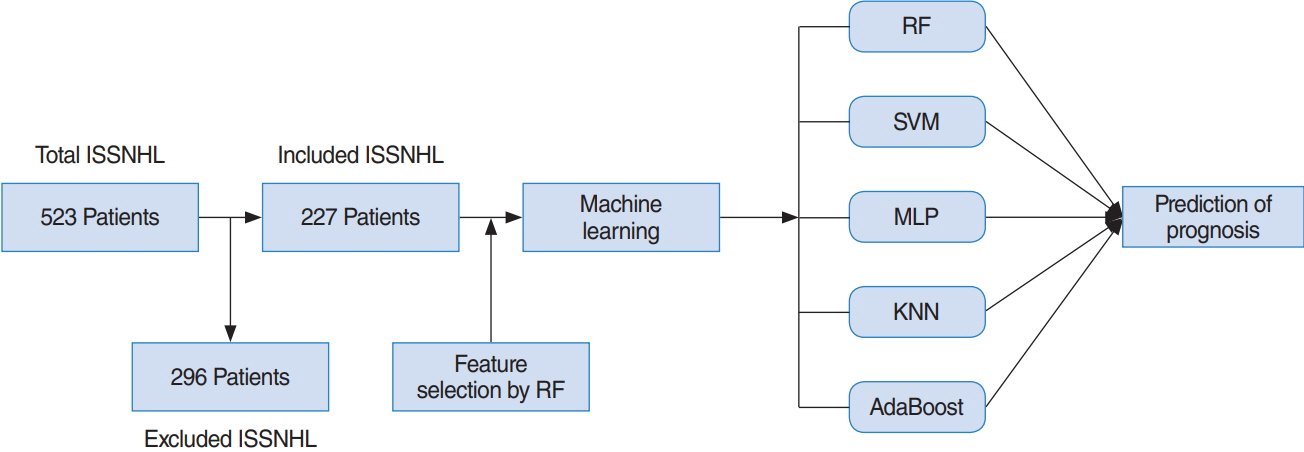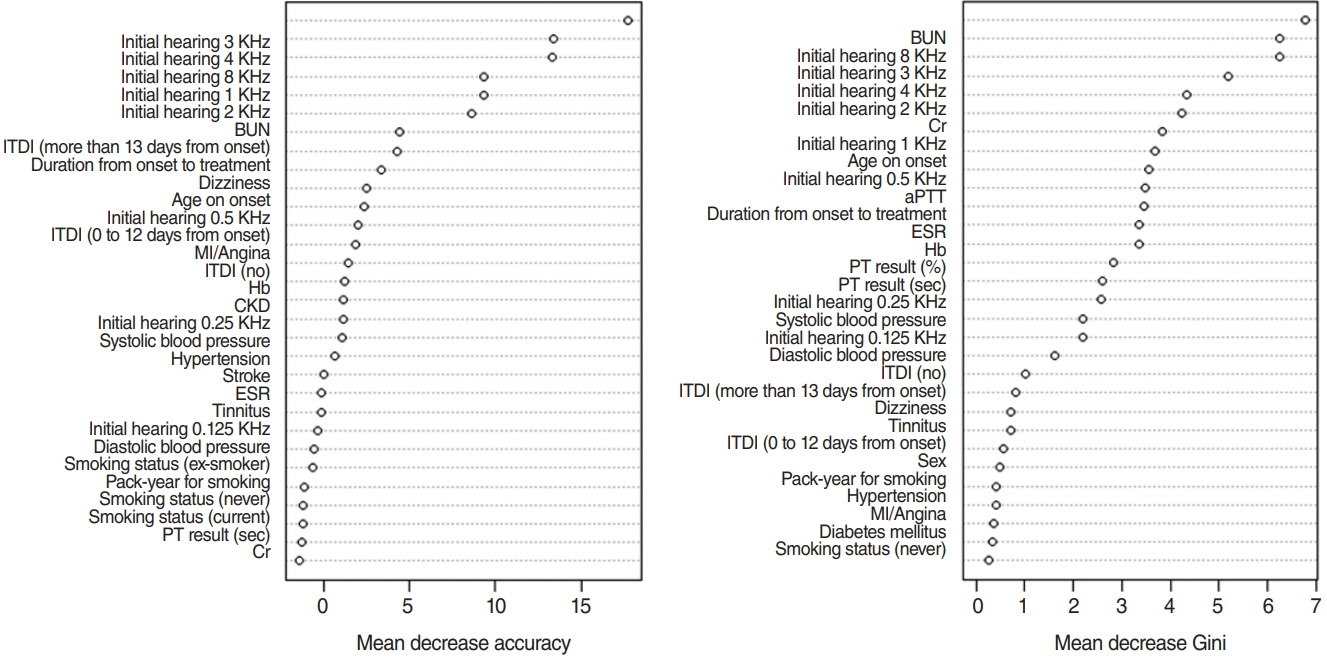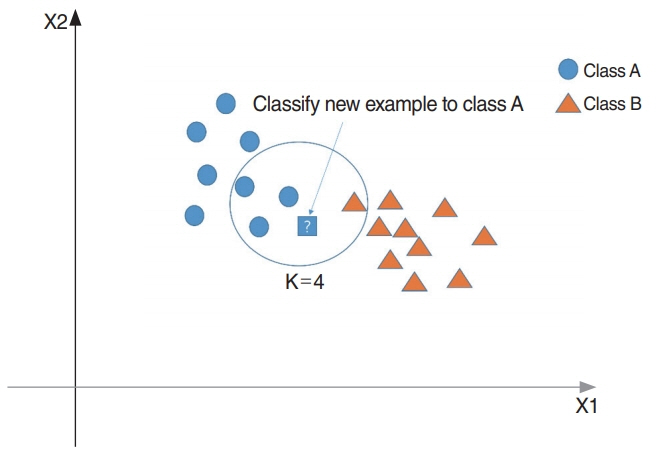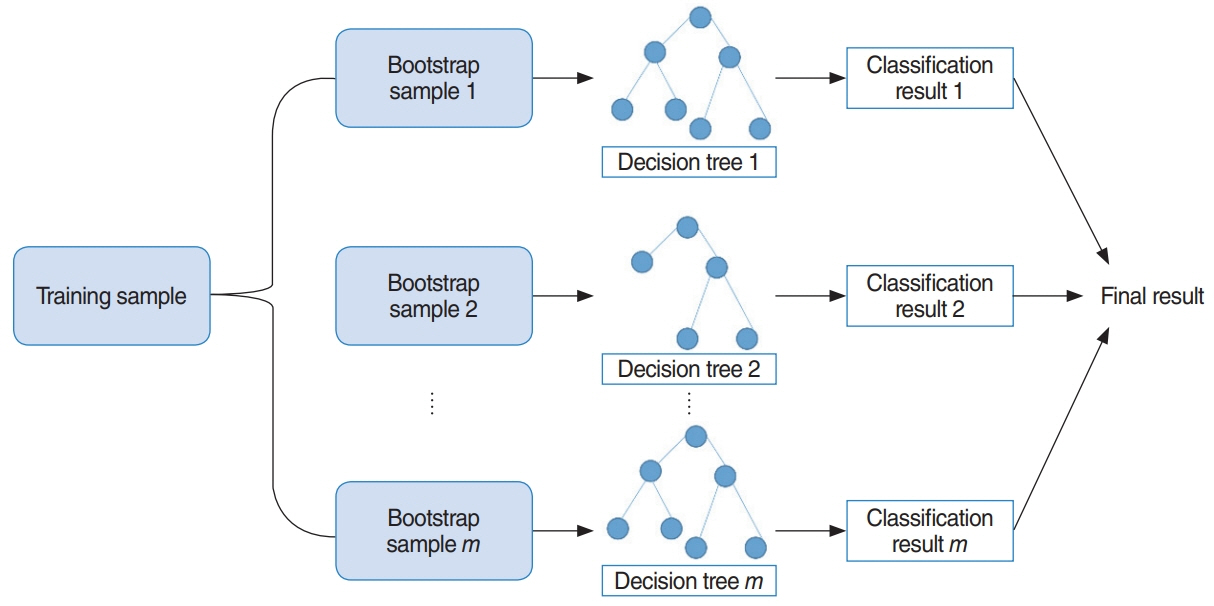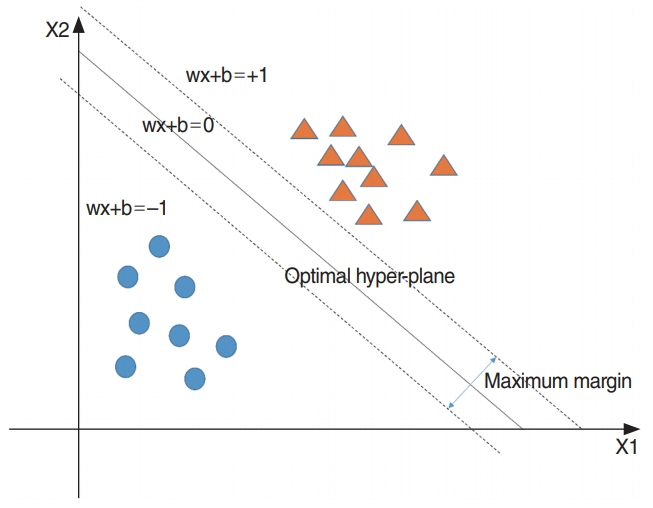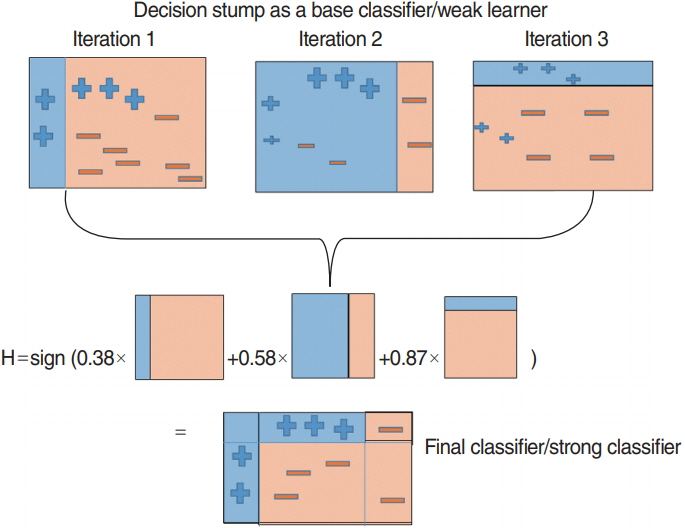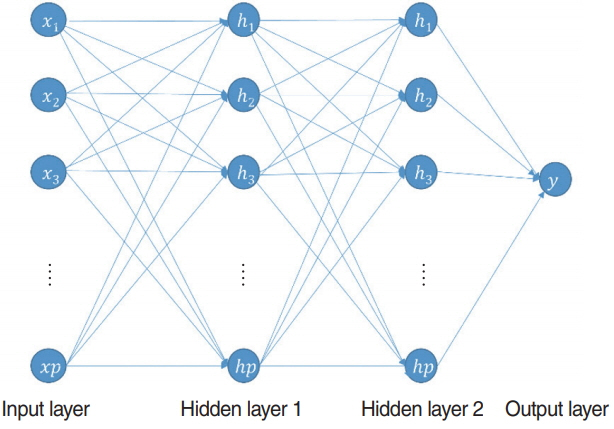Clin Exp Otorhinolaryngol.
2020 May;13(2):148-156. 10.21053/ceo.2019.01858.
Machine Learning Models for Predicting Hearing Prognosis in Unilateral Idiopathic Sudden Sensorineural Hearing Loss
- Affiliations
-
- 1School of Industrial Management Engineering, Korea University, Seoul, Korea
- 2Department of Otorhinolaryngology-Head and Neck Surgery, Korea University Ansan Hospital, Korea University College of Medicine, Ansan, Korea
- 3Department of Otorhinolaryngology-Head and Neck Surgery, Veterans Health Service Medical Center, Seoul, Korea
- KMID: 2500287
- DOI: http://doi.org/10.21053/ceo.2019.01858
Abstract
Objectives
. Prognosticating idiopathic sudden sensorineural hearing loss (ISSNHL) is an important challenge. In our study, a dataset was split into training and test sets and cross-validation was implemented on the training set, thereby determining the hyperparameters for machine learning models with high test accuracy and low bias. The effectiveness of the following five machine learning models for predicting the hearing prognosis in patients with ISSNHL after 1 month of treatment was assessed: adaptive boosting, K-nearest neighbor, multilayer perceptron, random forest (RF), and support vector machine (SVM).
Methods
. The medical records of 523 patients with ISSNHL admitted to Korea University Ansan Hospital between January 2010 and October 2017 were retrospectively reviewed. In this study, we analyzed data from 227 patients (recovery, 106; no recovery, 121) after excluding those with missing data. To determine risk factors, statistical hypothesis tests (e.g., the two-sample t-test for continuous variables and the chi-square test for categorical variables) were conducted to compare patients who did or did not recover. Variables were selected using an RF model depending on two criteria (mean decreases in the Gini index and accuracy).
Results
. The SVM model using selected predictors achieved both the highest accuracy (75.36%) and the highest F-score (0.74) on the test set. The RF model with selected variables demonstrated the second-highest accuracy (73.91%) and F-score (0.74). The RF model with the original variables showed the same accuracy (73.91%) as that of the RF model with selected variables, but a lower F-score (0.73). All the tested models, except RF, demonstrated better performance after variable selection based on RF.
Conclusion
. The SVM model with selected predictors was the best-performing of the tested prediction models. The RF model with selected predictors was the second-best model. Therefore, machine learning models can be used to predict hearing recovery in patients with ISSNHL.
Keyword
Figure
Cited by 1 articles
-
Application of Machine Learning in Rhinology: A State of the Art Review
Myeong Sang Yu
Korean J Otorhinolaryngol-Head Neck Surg. 2020;63(8):341-349. doi: 10.3342/kjorl-hns.2020.00633.
Reference
-
1. Bing D, Ying J, Miao J, Lan L, Wang D, Zhao L, et al. Predicting the hearing outcome in sudden sensorineural hearing loss via machine learning models. Clin Otolaryngol. 2018; Jun. 43(3):868–74.
Article2. Weiss D, Bocker AJ, Koopmann M, Savvas E, Borowski M, Rudack C. Predictors of hearing recovery in patients with severe sudden sensorineural hearing loss. J Otolaryngol Head Neck Surg. 2017; Apr. 46(1):27.
Article3. Stachler RJ, Chandrasekhar SS, Archer SM, Rosenfeld RM, Schwartz SR, Barrs DM, et al. Clinical practice guideline: sudden hearing loss. Otolaryngol Head Neck Surg. 2012; Mar. 146(3 Suppl):S1–35.
Article4. Lin RJ, Krall R, Westerberg BD, Chadha NK, Chau JK. Systematic review and meta-analysis of the risk factors for sudden sensorineural hearing loss in adults. Laryngoscope. 2012; Mar. 122(3):624–35.
Article5. Han X, Yin X, Du X, Sun C. Combined intratympanic and systemic use of steroids as a first-line treatment for sudden sensorineural hearing loss: a meta-analysis of randomized, controlled trials. Otol Neurotol. 2017; Apr. 38(4):487–95.
Article6. Cao Z, Li Z, Xiang H, Huang S, Gao J, Zhan X, et al. Prognostic role of haematological indices in sudden sensorineural hearing loss: review and meta-analysis. Clin Chim Acta. 2018; Aug. 483:104–11.
Article7. Suzuki H, Tabata T, Koizumi H, Hohchi N, Takeuchi S, Kitamura T, et al. Prediction of hearing outcomes by multiple regression analysis in patients with idiopathic sudden sensorineural hearing loss. Ann Otol Rhinol Laryngol. 2014; Dec. 123(12):821–5.
Article8. Suzuki H, Mori T, Hashida K, Shibata M, Nguyen KH, Wakasugi T, et al. Prediction model for hearing outcome in patients with idiopathic sudden sensorineural hearing loss. Eur Arch Otorhinolaryngol. 2011; Apr. 268(4):497–500.
Article9. Chao TK, Hsiu-Hsi Chen T. Predictive model for improvement of idiopathic sudden sensorineural hearing loss. Otol Neurotol. 2010; Apr. 31(3):385–93.
Article10. Cvorovic L, Deric D, Probst R, Hegemann S. Prognostic model for predicting hearing recovery in idiopathic sudden sensorineural hearing loss. Otol Neurotol. 2008; Jun. 29(4):464–9.11. Zhao Y, Li J, Zhang M, Lu Y, Xie H, Tian Y, et al. Machine learning models for the hearing impairment prediction in workers exposed to complex industrial noise: a pilot study. Ear Hear. 2019; May/Jun. 40(3):690–9.
Article12. Jun HJ, Chang J, Im GJ, Kwon SY, Jung H, Choi J. Analysis of frequency loss as a prognostic factor in idiopathic sensorineural hearing loss. Acta Otolaryngol. 2012; Jun. 132(6):590–6.
Article13. Breiman L. Random forests. Mach Learn. 2001; 45:5–32.14. Elgamal M. Automatic skin cancer images classification. Int J Adv Comput Sci Appl. 2013; 4(3):287–94.
Article15. Burges CJ. A tutorial on support vector machines for pattern recognition. Data Min Knowl Discov. 1998; 2:121–67.16. Freund Y, Schapire RE. A decision-theoretic generalization of on-line learning and an application to boosting. J Comput Syst Sci. 1997; 55(1):119–39.
Article
- Full Text Links
- Actions
-
Cited
- CITED
-
- Close
- Share
- Similar articles
-
- A Case of Dolichoectasia of Vertebrobasilar Artery Presenting Simultaneous Bilateral Sudden Sensorineural Hearing Loss with Vertigo
- Idiopathic Sudden Sensorineural Hearing Loss With Minimal Hearing Impairment
- Fatal Case of Klebsiella Meningitis Combined with Bilateral Sudden Sensorineural Hearing Loss: A Case Report and Literature Review
- Medulloblastoma Manifesting as Sudden Sensorineural Hearing Loss
- Acute Low Tone Sensorineural Hearing Loss: Consideration for Progression to Meniere's Disease

